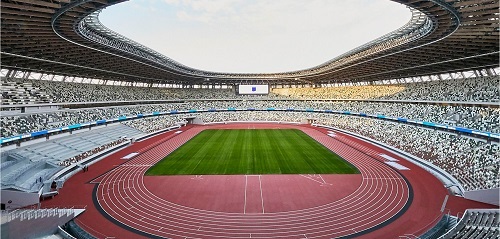
BY ADDISALEM MULAT
Ethiopia has been partaking in the Olympic Games once every four years in a wide variety of Olympic events that bring the world together for the most part in track running, road running and across country running.
As Ethiopian athletes turn out to be triumphant over track and field sports over and over again, all and sundry look forward the Olympic day to come and feel over the moon.
As a matter of fact, the success journey of Ethiopia athletes is strongly associated with the world famous Ethiopian marathon runner who goes by the name of Abebe Bikila. On top of that quite a lot of Ethiopian athletes have won the hearts and minds of the world through their effective racing strategies and tactics such as Mamo Wolde, Haile Gebreselassie, Miruts Yifter, Kenenisa Bekele, Tirunesh Dibaba, Derertu Tulu, and what have you.
The unique running style of Abebe Bikila has made him to be remembered always by the world.
To begin, in the 1960 Olympic Games in Rome, Ethiopian marathon runner Abebe Bikila had been added to the team at the last minute and had then astonished the world by winning the Olympic title while competing in barefoot. In Tokyo, inadvertently, he delivered a victory that was every bit as amazing, according to information obtained from International Olympic Committee website.
This time there was no doubting his star quality, but his fitness was in great question. First days before the Olympic marathon was due to start, he had started to feel discomfort while on a training run in the Ethiopian capital, Addis Ababa. He decided to preserve, but then collapsed in agony and was taken hospital.
Doctors quickly diagnosed acute appendicitis and six weeks before his event, removed his appendix. Few gave him any chance of competing, but as he remained in hospital, the indomitable Bikila started jogging in the courtyard. He travelled to Tokyo with the team, entered the marathon and, to general amazement, lined up as the start. Nobody was sure what to expect- and nobody predicted he would dominate in the way he did.
His lead got ever bigger and by the time he entered the Olympic Stadium, applaud Bikila across the line, stunned by both his margin of victory and by the lack of exhaustion. By the time Basil Heatley, of Great Britain, arrived to claim silver, Bikila was calmly doing stretching exercises, having recovered from his exertions.
He was acclaimed as a hero, once more, when he arrived back in Ethiopia. As a mark of his triumph, Bikila was presented with a car- a white Volkswagen Beetle.
In the Tokyo 2020 Olympics, Ethiopian runners are expected that they would repeat the same history provided that they are in good shape. Unless they come across a certain glitches related to the weather condition and health problems, nothing can stop them from winning the marathon race.
In fact, in the Tokyo Olympic, Ethiopians are expected that they would win various competitions. A wide variety of Ethiopian athletes would partake in the event.
World record-holders Letesenbet Gidey and Gudaf Tsegay are among the 34 athletes named on Ethiopia’s team for the Tokyo Olympic Games, according to the world athletics website.
Although qualified in more than one event, Gidey and Tsegay – like all other members of the team – will focus on just one event each. Gidey will contest the 10,000m, the event at which she set a world record of 29:01.03 last month, while Tsegay will line up for the 5000m, having clocked a world-leading 14:13.32 in Hengelo on 8 June.
The team also includes world indoor 1500m champion Samuel Tefera and world silver medallists Selemon Barega and Yomif Kejelcha.
According to abc eyewitness news, billions of people watch the Olympics. It’s where stars are born. And usually, the first star of the games is not a person but where the opening ceremony takes place.
This year it’s Japan’s brand-new National Stadium. The beauty of Japan lies within its simplicity: a vivid green rice field, the powerful Pacific and centuries-old temples. In Japan, it is about connection to nature, tradition and culture where the smallest gesture makes the largest statement.
In this society, to simply give a gift – not expensive but meaningful – is so important. It’s a sign of respect. When you come to visit, it’s common to receive a gesture of welcome.
The gift David Ono received when visiting Japan? A book. And inside the inscription says, “To David” and signed “Keng Kuma”.
Kengo Kuma is the architect who designed the Japan National Stadium, the grand stage for the Tokyo Olympics. His latest creation will soon be the center of the universe, achieving a level of fame reserved for only the finest in the world. Yet, this thoughtful man took a moment to welcome a stranger.
The stadium is not just a building, it’s a symbol of Japan. Instead of a giant behemoth of just concrete and steel, Kuma added something he sees as very important to Japanese tradition: wood. He used 47 types of wood from the 47 prefectures that make up Japan and, as big as the stadium is, he still wants it to show just the opposite: the smallness of Tokyo.
In the present climate, the world is enjoying the various activities that have been undertaking in the National Stadium of Japan.
Frankly speaking, following the COVID-19 pandemic the Tokyo 2020 Olympics has passed through many ups and downs to reach where it is in the present day. Nobody had expected the Olympic game would go ahead as planned as it was postponed to a certain time.
According to Reuters a top medical organization has thrown its weight behind calls to cancel the Tokyo Olympics saying hospitals are already overwhelmed as the country battles a spike in coronavirus infections less than three months from the start of the Games.
Despite all the difficulties, the great competition is going smoothly so far. Belated and beleaguered, the virus-delayed Tokyo Summer Olympics finally opened last Friday night with cascading fireworks and made-for-TV choreography that unfolded in a near-empty stadium, a colorful but strangely subdued ceremony that set a striking tone to match a unique pandemic Games, AP reported .
As their opening played out, devoid of the usual crowd energy, the Olympics convened\ amid simmering anger and disbelief in much of the host country, but with hopes from organizers that the excitement of the sports to follow would offset the widespread opposition.
“Today is a moment of hope. Yes, it is very different from what all of us had imagined,” IOC President Thomas Bach said. “But let us cherish this moment because finally we are all here together.”
“This feeling of togetherness — this is the light at the end of the dark tunnel of the pandemic,” Bach declared. Later, Japanese tennis star Naomi Osaka received the Olympic flame from a torch relay through the stadium and lit the Olympic cauldron.
Energized by past sprit and strong connection with its athletes, Ethiopia is awaiting its turn to make it to the medal list when athletics is officialy begins. Different media reports are compiled to prepare the story.
The Ethiopian Herald July 30/2021





